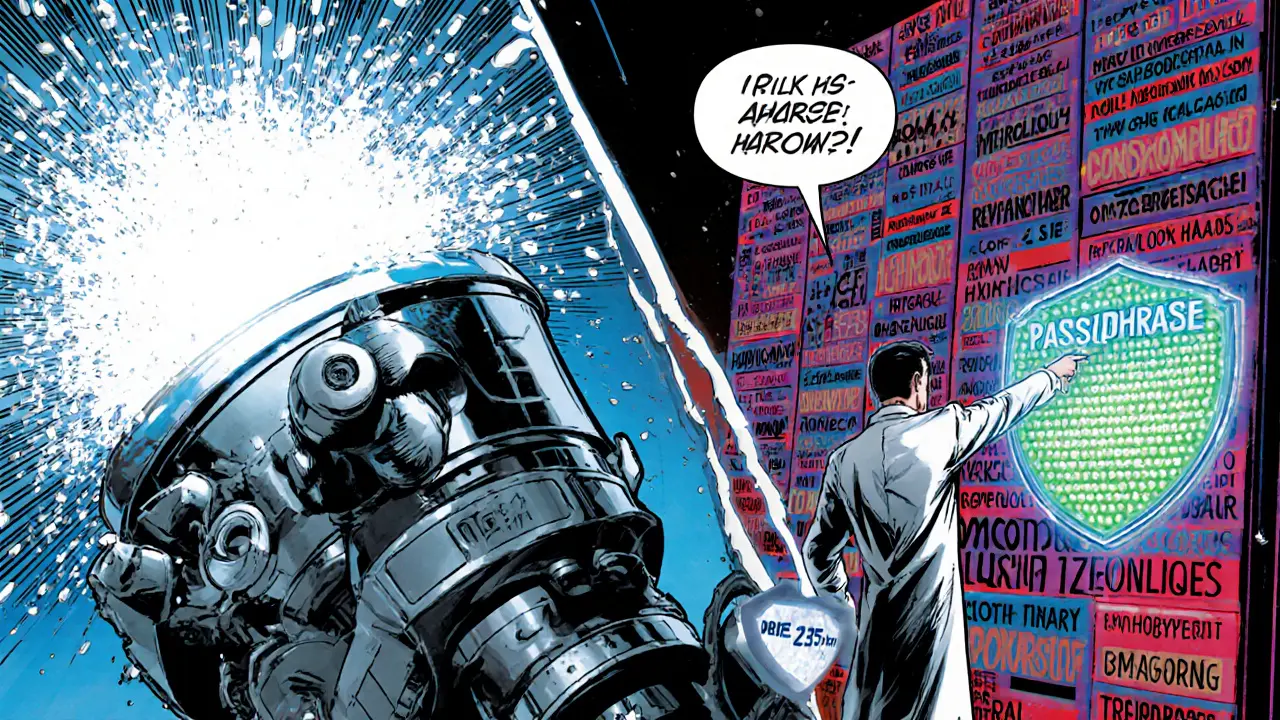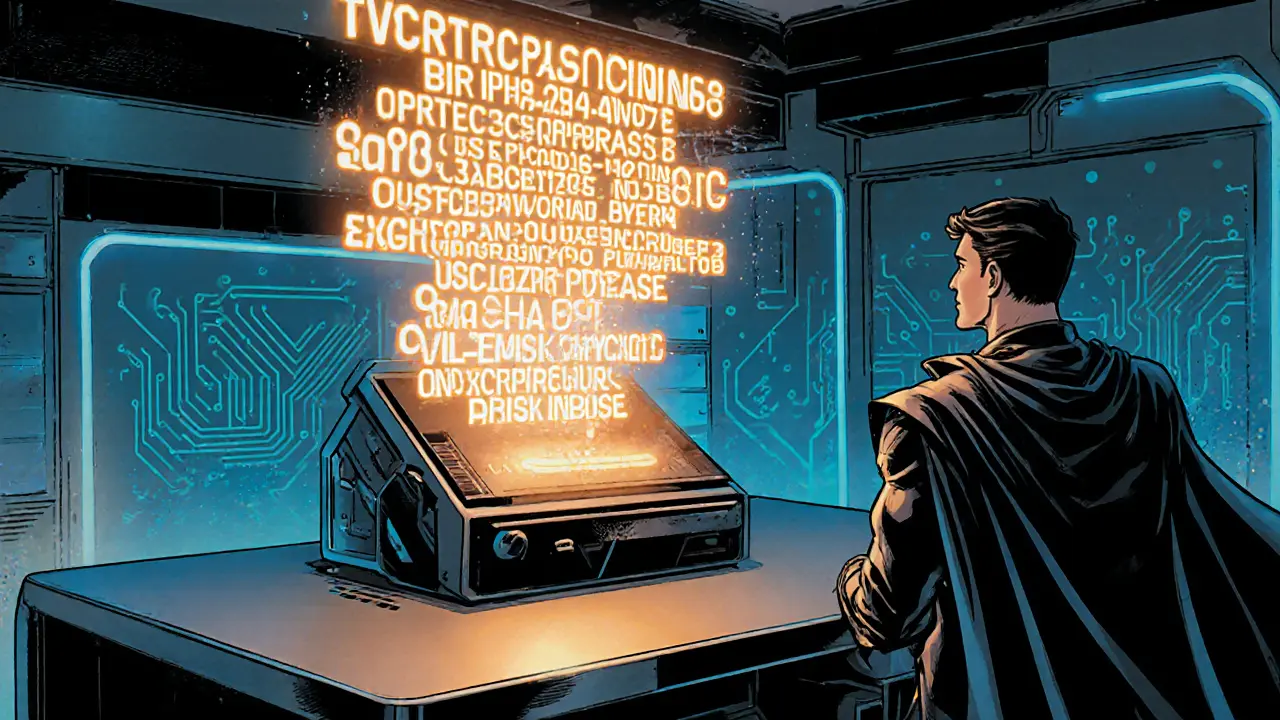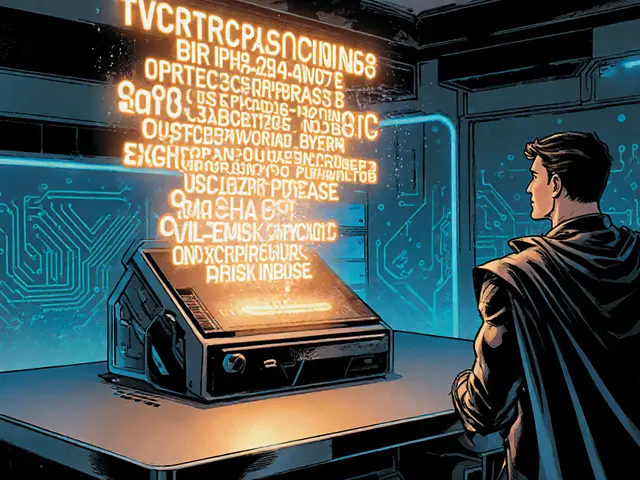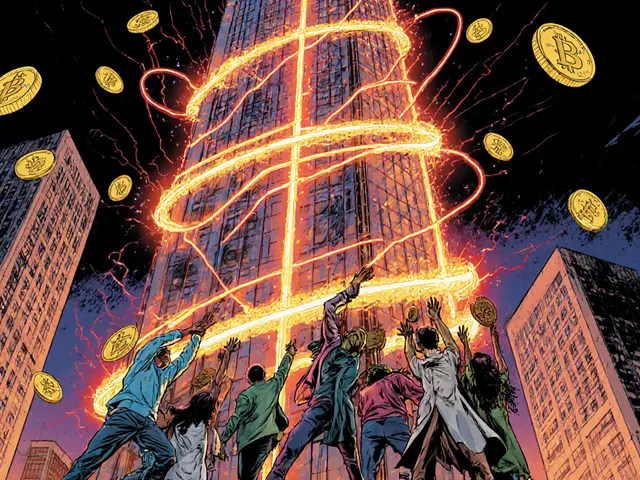Understanding BIP39 Seed Phrase Standard: A Practical Guide
BIP39 Security Calculator
Security Analysis
About BIP39 Security
12-word phrases provide 128 bits of security, matching a single Bitcoin private key. 24-word phrases provide 256 bits, which is far beyond current computational capabilities to brute-force.
A passphrase adds an additional layer of security, but also increases the risk of loss if forgotten.
TL;DR
- BIP39 defines a 2048‑word list that turns random bits into a human‑readable seed phrase.
- 12‑word phrases give ~128bits of security; 24‑word phrases double that.
- The seed phrase (mnemonic) plus an optional passphrase is the master key to all your crypto assets.
- Never write your own phrase - let the wallet generate it with proper randomness.
- Store the phrase and any passphrase in multiple secure locations; loss equals loss of funds.
When you hear about BIP39 a Bitcoin Improvement Proposal that standardizes how cryptocurrency wallets create and restore accounts using mnemonic seed phrases, the first question is usually: "What does that actually mean for me?" This article breaks down the technical bits, the security math, and the real‑world habits you need to keep your crypto safe.
What Is BIP39?
BIP39 is a protocol that defines a 2048‑word dictionary and the algorithm for turning random entropy into a mnemonic seed phrase. It was introduced to solve the messy problem of backing up raw private keys, which are long, unintelligible strings that are easy to mistype or lose. By converting those keys into a list of common words, BIP39 made wallet recovery user‑friendly and interoperable across every major crypto wallet.
How the Seed Phrase Is Built
The process starts with entropy cryptographically secure random data, typically 128bits for a 12‑word phrase or 256bits for 24 words. That entropy is hashed with SHA‑256, and a short checksum (the first few bits of the hash) is appended. The combined bit‑string is then split into 11‑bit chunks. Each chunk maps to a number between 0 and 2047, which selects a word from the wordlist a fixed set of 2048 English words, each uniquely identifiable by its first four letters.
For a 12‑word phrase you get 128bits of entropy plus a 4‑bit checksum, yielding 132bits that become twelve 11‑bit indexes. The same math works for 24‑word phrases, but with 256bits of entropy and an 8‑bit checksum, giving 264bits total.
Mnemonic vs. Passphrase: Two Layers of Security
The resulting list of words is called a mnemonic phrase the human‑readable representation of the underlying seed. Some wallets let you add a passphrase an optional user‑chosen string that is combined with the mnemonic to produce a different seed. Think of the passphrase as a 25th (or 13th) word that only you know.
BIP39 seed phrase alone is already strong, but the extra passphrase adds a second secret. Lose either the phrase or the passphrase and you lose access to your funds. Because of this double‑secret nature, many wallets disable the passphrase feature by default.
Security Numbers You Can Trust
Despite the massive theoretical space (2048^12 ≈ 2^132), the checksum reduces effective security to 128bits for 12‑word phrases. That matches the security level of a single Bitcoin private key, which is considered unbreakable with today’s computing power. A 24‑word phrase bumps the security to 256bits, far beyond any realistic brute‑force attack.
| Metric | 12‑word phrase | 24‑word phrase |
|---|---|---|
| Entropy bits | 128 | 256 |
| Checksum bits | 4 | 8 |
| Total bits | 132 | 264 |
| Effective security | 128bits | 256bits |
| Typical use case | Most consumer wallets | High‑value or institutional storage |

Why BIP39 Beats Raw Private Keys
With a raw private key, a single typo or smudge makes the key unusable. The wordlist’s built‑in error correction allows users to recover from minor transcription errors because the first four letters of each word are unique. Moreover, any BIP39‑compatible wallet can restore the same set of addresses, so you’re not locked into a single app. That cross‑compatibility is why the entire cryptocurrency industry-from Bitcoin to Ethereum and beyond-has converged on BIP39.
Common Pitfalls and How to Avoid Them
- Don’t generate your own phrase. Human‑picked words lack the required randomness and drastically reduce security.
- Store the phrase offline. Taking a screenshot or saving it in the cloud exposes it to hacks.
- If you use a passphrase, keep it separate from the phrase. Treat them like two keys to the same safe.
- Write it clearly. Even though the first four letters are unique, illegible handwriting can still cause irrecoverable loss.
- Make multiple copies and keep them in geographically separated, fire‑proof locations.
Practical Steps to Generate and Backup Your BIP39 Phrase
- Download a reputable wallet (e.g., Ledger, Trezor, or a trusted mobile app).
- During the initial setup, let the app create a new wallet. The software will pull true random numbers from the device’s hardware RNG.
- When the 12‑ or 24‑word phrase appears, record it on paper. Use a pen with archival ink; avoid pencil.
- Verify the phrase by re‑entering it in the wallet interface. This ensures no transcription errors.
- If you decide to use a passphrase, write it on a separate sheet and store it in a different secure spot.
Recovering a Lost Phrase: What to Expect
Services like DataRecovery.com specialize in helping users who have partially damaged or incomplete phrases. Their process usually involves:
- Collecting every piece of the phrase you still have (even a single word).
- Using brute‑force tools that exploit the checksum to prune impossible combinations.
- Attempting recovery only if you can prove ownership of the original wallet.
Future of BIP39
As of October2025, BIP39 remains actively maintained. Updates focus on expanding language wordlists (adding more scripts for global adoption) and improving educational material around passphrase usage. No credible alternative has yet matched its blend of simplicity, security, and universal compatibility, so you can count on BIP39 being the backbone of wallet recovery for years to come.
Frequently Asked Questions
Can I use a BIP39 phrase from one wallet in another?
Yes. Any wallet that follows the BIP39 standard can import the same mnemonic and recreate the identical set of private keys, regardless of the brand.
What’s the difference between a seed phrase and a private key?
A private key is a 256‑bit number that directly controls a single address. A seed phrase is a human‑readable encoding of entropy that can generate a whole hierarchy of private keys for multiple addresses.
How many words should I choose: 12 or 24?
For everyday use, a 12‑word phrase is sufficient and easier to back up. If you’re holding large amounts or managing institutional funds, a 24‑word phrase adds an extra security margin.
Is a passphrase required?
No. The passphrase is optional and meant for users who want a second secret. However, if you enable it, you must store it safely because losing it means losing access.
Can I write my seed phrase on a digital device?
It’s strongly discouraged. Digital copies can be exposed to malware, phishing, or cloud breaches. Paper or metal backups are the safest offline options.
Mastering BIP39 isn’t about memorizing 2048 words; it’s about understanding how a short, well‑protected phrase becomes the master key to all your crypto assets. Follow the steps, respect the backup rules, and you’ll keep your digital wealth safe for the long haul.









In the labyrinth of cryptographic abstractions, the BIP‑39 seed phrase stands as a paradoxical beacon; a string of simple words, yet a fortress of entropy, demanding our reverent attention, lest we wander into the abyss of lost keys.
One might argue that the elegance of converting raw bits into mnemonic syllables is a triumph of human‑centric design, but the underlying mathematics remains unforgiving, immutable, and relentless.
Thus, the act of safeguarding one's phrase transcends mere habit-it becomes a ritual, a covenant between the user and the immutable ledger, sealed by ink, metal, or whatever vault we deem trustworthy.
The calculator presented herein serves not merely as an illustration, but as a stark reminder: entropy is quantifiable, but vigilance is priceless.
In short, treat your seed phrase as you would a priceless heirloom, because it literally is.
Oh, sure, treat it like a priceless heirloom-because we all have a safe deposit box for twelve random words, right?
Your poetic lament is appreciated, but the real world prefers simple backups over lyrical musings.
i love how easy seed phrases are lol 😍😂
What they don't tell you is that those 12 words are probably being watched by unseen forces, hidden in the code of the network, waiting for a slip‑up.
Every time you write it down, you leave a breadcrumb for the watchers.
So maybe keep it under your mattress, not in the cloud.
Alright, let’s unpack the entire BIP‑39 ecosystem from a mentor’s perspective.
First, understand that the 2048‑word list isn’t a random cafeteria menu; it’s a rigorously curated set designed for error detection, which means each word’s first four letters are unique, giving you a built‑in safety net against transcription mistakes.
Second, the entropy you receive-128 bits for a 12‑word phrase or 256 bits for a 24‑word phrase-is generated by hardware‑level random number generators, which are orders of magnitude more unpredictable than anything a human could muster.
Now, onto backup strategies: paper is the classic, but it’s vulnerable to fire, water, and termites; metal‑plate backups (stainless steel or titanium) can survive these threats, but they’re less flexible for editing.
Best practice is redundancy across media: write the seed on archival‑grade paper, laminate it, and also imprint it on a stainless‑steel wallet like the Billfodl or CryptoStash.
Storage locations matter just as much as the media.
Distribute copies across at least three geographically separated sites-think a home safe, a bank deposit box, and a trusted family member’s residence.
This tri‑location strategy mitigates risks from natural disasters, theft, and even the occasional fire in the kitchen.
If you opt for a passphrase, treat it as a 25th word that lives in a completely different vault.
Never store the passphrase on the same physical medium as the seed; a common mistake is to scribble both on a single sheet, which defeats the purpose of layered security.
Testing your backup is essential.
Every six months, simulate a recovery on an air‑gapped device by inputting the mnemonic (and passphrase, if used) into a fresh wallet to confirm that every word is legible and the process works end‑to‑end.
This rehearsal builds confidence and catches hidden errors before they become catastrophic.
Finally, educate yourself continuously.
The crypto space evolves, and standards may be refined; staying informed through reputable blogs, official BIP repositories, and community forums ensures you’re never caught off‑guard by a new vulnerability.
In summary: generate with a hardware‑backed wallet, back up redundantly across media and locations, keep the passphrase separate, rehearse recovery, and keep learning.
While your enthusiasm paints a vivid picture, let's not forget that over‑complicating the backup process can backfire, especially for newcomers.
A balanced approach-paper plus a metal plate-keeps things simple and reliable.
Remember, clarity beats flamboyance when it comes to security.
Exactly, and to add a practical tip: laminate your paper backup using an archival‑grade kit, then store the metal replica in a fire‑proof safe.
This dual‑layer method mitigates both water and fire risks, which are the most common threats.
Also, avoid writing the passphrase on the same sheet as the seed; treat them as separate secrets.
Finally, test your recovery process periodically by importing the phrase into a fresh wallet on an offline machine.
Consistent rehearsal ensures you truly understand the steps before an emergency arises.
Sure, but you can’t ignore the fact that most people just scribble the phrase on a sticky note and hope for the best-it's almost comical how naive the community can be.
I’d argue that a cultural shift toward hardware‑backed key management is overdue.
Still, your suggestions are solid, if a bit too textbook.
Philosophically speaking, the act of writing down a seed phrase is an inscription of trust onto the material world, a gesture that transforms abstract cryptographic entropy into a tangible artifact, thereby bridging the metaphysical divide between code and flesh; this bridging, however, is fraught with paradoxes, because the very permanence we seek is threatened by the impermanence of our own bodies and environments.
When we contemplate the metal plates you mentioned, we must also consider the temporality of metals-corrosion, oxidation, and the inevitable decay that time imposes.
Consequently, the ideal preservation strategy involves a layered redundancy: scientific, environmental, and sociocultural.
In practice, my recommendation is to distribute copies across three geographic locations, each with a distinct medium-paper, stainless steel, and a sealed polymer.
This triadic approach not only safeguards against localized disasters but also diffuses the risk of a single point of failure.
Moreover, by involving trusted individuals in each location, we embed a social recovery mechanism that can outlive any single holder.
Right, because everyone has three trusted friends just lying around, ready to guard metal plates.
Great plan, buddy.
Stay safe and keep those backups offline.